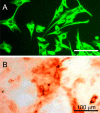Tenascin-C Expression in Equine Tendon-derived Cells During Proliferation and Migration
- PMID: 24833997
- PMCID: PMC4013982
- DOI: 10.1294/jes.24.17
Tenascin-C Expression in Equine Tendon-derived Cells During Proliferation and Migration
Abstract
In vitro cell studies might be a useful tool for studying tendon pathology, but no suitable in vitro models exist for tendon disorders. The purpose of this study was to confirm whether cell scratch culture using tendon-derived fibroblasts can provide a suitable in vitro tendon disorder model. Extracellular matrix components were examined immunohistochemically in tendon tissue, and then their related gene expression levels were analyzed by conventional reverse transcription polymerase chain reaction (RT-PCR) and/or quantitative real-time RT-PCR in tissues and cells. Collagen type I (Col I), collagen type III (Col III), tenascin-C (TN-C) and cartilage oligomeric matrix protein (COMP) were detected in tendon tissue sections, and RT-PCR confirmed their expression in tendon tissue and cells. Cells that had been cultured from explanted tendon tissue maintained the characteristics of in vivo tendon cells. The combination of TN-C and COMP might be a useful marker of tendon cells because they display more tendon-specific expression than Col I and III. In particular, the significant increase of TN-C mRNA expression in the scratch wound assay, at 12 hr after scratching, concomitant with the regeneration of the cell sheet, indicates its crucial role in tendon cell proliferation and migration. Thus, TN-C appears to be a key factor in tendon wound healing. In vitro cell scratch assays using tendon cells appear to mimic the repair of tendon tissue after injury.
Keywords: cartilage oligomeric matrix protein; collagen; equine tendon; scratch wound assay; tenascin-C.
Figures




Similar articles
-
Responses of equine tendon- and bone marrow-derived cells to monolayer expansion with fibroblast growth factor-2 and sequential culture with pulverized tendon and insulin-like growth factor-I.Am J Vet Res. 2012 Jan;73(1):162-70. doi: 10.2460/ajvr.73.1.162. Am J Vet Res. 2012. PMID: 22204303
-
Growth/differentiation factor-5 modulates the synthesis and expression of extracellular matrix and cell-adhesion-related molecules of rat Achilles tendon fibroblasts.Connect Tissue Res. 2011;52(4):353-64. doi: 10.3109/03008207.2010.534208. Epub 2011 Jan 20. Connect Tissue Res. 2011. PMID: 21250863
-
Comparison of equine tendon- and bone marrow-derived cells cultured on tendon matrix with or without insulin-like growth factor-I supplementation.Am J Vet Res. 2012 Jan;73(1):153-61. doi: 10.2460/ajvr.73.1.153. Am J Vet Res. 2012. PMID: 22204302
-
Collagen VI-NG2 axis in human tendon fibroblasts under conditions mimicking injury response.Matrix Biol. 2016 Sep;55:90-105. doi: 10.1016/j.matbio.2016.02.012. Epub 2016 Mar 2. Matrix Biol. 2016. PMID: 26944560
-
Tenascin-C in the pathobiology and healing process of musculoskeletal tissue injury.Scand J Med Sci Sports. 2000 Dec;10(6):376-82. doi: 10.1034/j.1600-0838.2000.010006376.x. Scand J Med Sci Sports. 2000. PMID: 11085568 Review.
Cited by
-
Mesenchymal Stem Cells Use in the Treatment of Tendon Disorders: A Systematic Review and Meta-Analysis of Prospective Clinical Studies.Ann Rehabil Med. 2021 Aug;45(4):274-283. doi: 10.5535/arm.21078. Epub 2021 Aug 30. Ann Rehabil Med. 2021. PMID: 34496470 Free PMC article.
-
Stress deprivation of tendon explants or Tpm3.1 inhibition in tendon cells reduces F-actin to promote a tendinosis-like phenotype.Mol Biol Cell. 2022 Dec 1;33(14):ar141. doi: 10.1091/mbc.E22-02-0067. Epub 2022 Sep 21. Mol Biol Cell. 2022. PMID: 36129771 Free PMC article.
-
Cell therapy efficacy and safety in treating tendon disorders: a systemic review of clinical studies.J Exp Orthop. 2022 Aug 30;9(1):85. doi: 10.1186/s40634-022-00520-9. J Exp Orthop. 2022. PMID: 36042110 Free PMC article. Review.
-
Tendon Extracellular Matrix Alterations in Ullrich Congenital Muscular Dystrophy.Front Aging Neurosci. 2016 Jun 8;8:131. doi: 10.3389/fnagi.2016.00131. eCollection 2016. Front Aging Neurosci. 2016. PMID: 27375477 Free PMC article.
-
Tendon Extracellular Matrix Remodeling and Defective Cell Polarization in the Presence of Collagen VI Mutations.Cells. 2020 Feb 11;9(2):409. doi: 10.3390/cells9020409. Cells. 2020. PMID: 32053901 Free PMC article.
References
-
- Chiquet-Ehrismann R., Tucker R.P.2004. Connective tissues: signalling by tenascins. Int. J. Biochem. Cell Biol. 36: 1085–1089 - PubMed
-
- Dahlgren L.A., Brower-Toland B.D., Nixon A.J.2005. Cloning and expression of type III collagen in normal and injured tendons of horses. Am. J. Vet. Res. 66: 266–270 - PubMed
-
- Dahlgren L.A., Mohammed H.O., Nixon A.J.2005. Temporal expression of growth factors and matrix molecules in healing tendon lesions. J. Orthop. Res. 23: 84–92 - PubMed
-
- DiCesare P., Hauser N., Lehman D., Pasumarti S., Paulsson M.1994. Cartilage oligomeric matrix protein (COMP) is an abundant component of tendon. FEBS Lett. 354: 237–240 - PubMed
-
- Dowling B.A., Dart A.J.2005. Mechanical and functional properties of the equine superficial digital flexor tendon. Vet. J. 170: 184–192 - PubMed
LinkOut - more resources
Full Text Sources
Other Literature Sources
Miscellaneous
